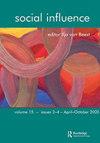Social mindfulness in the real world: the physical presence of others induces other-regarding motivation
IF 0.6
3区 心理学
Q3 PSYCHOLOGY, SOCIAL
引用次数: 18
Abstract
ABSTRACT Two studies show that being socially mindful only requires a minimal social context: The presence of a specific other is enough to bring out greater social mindfulness in a one-shot social decision-making task that focuses participants’ decisions on leaving or limiting other people’s choice. Study 1 contrasts a control condition (with no second chooser) with two conditions in which a confederate chooses after the participant. We find that participants are socially mindful by leaving choice to the confederate more often. Study 2 reveals that a specified, identifiable other is left choice more often than an unspecified next chooser. The physical presence of others may thus be enough to elicit greater social mindfulness as manifested in simple and low-cost social decision-making.现实世界中的社会正念:他人的实际存在引发了与他人相关的动机
两项研究表明,保持社会正念只需要最小的社会背景:在一次性社会决策任务中,特定他人的存在足以使参与者的决定集中在离开或限制他人的选择上,从而产生更大的社会正念。研究1对比了一个控制条件(没有第二个选择者)和两个条件,在两个条件下,一个同谋者在参与者之后选择。我们发现,参与者通过更多地把选择留给同盟者,从而更加注重社交。研究2表明,一个特定的、可识别的其他人比一个未指定的下一个选择者更经常被留下选择。因此,其他人的实际存在可能足以引起更大的社会意识,这体现在简单和低成本的社会决策中。
本文章由计算机程序翻译,如有差异,请以英文原文为准。
求助全文
约1分钟内获得全文
求助全文
来源期刊

Social Influence
PSYCHOLOGY, SOCIAL-
CiteScore
1.50
自引率
0.00%
发文量
4
期刊介绍:
Social Influence is a journal that provides an integrated focus for research into this important, dynamic, and multi-disciplinary field. Topics covered include: conformity, norms, social influence tactics such as norm of reciprocity, authority, scarcity, interpersonal influence, persuasion, power, advertising, mass media effects, political persuasion, propaganda, comparative influence, compliance, minority influence, influence in groups, cultic influence, social movements, social contagions, rumors, resistance to influence, influence across cultures, and the history of influence research.
 求助内容:
求助内容: 应助结果提醒方式:
应助结果提醒方式:


